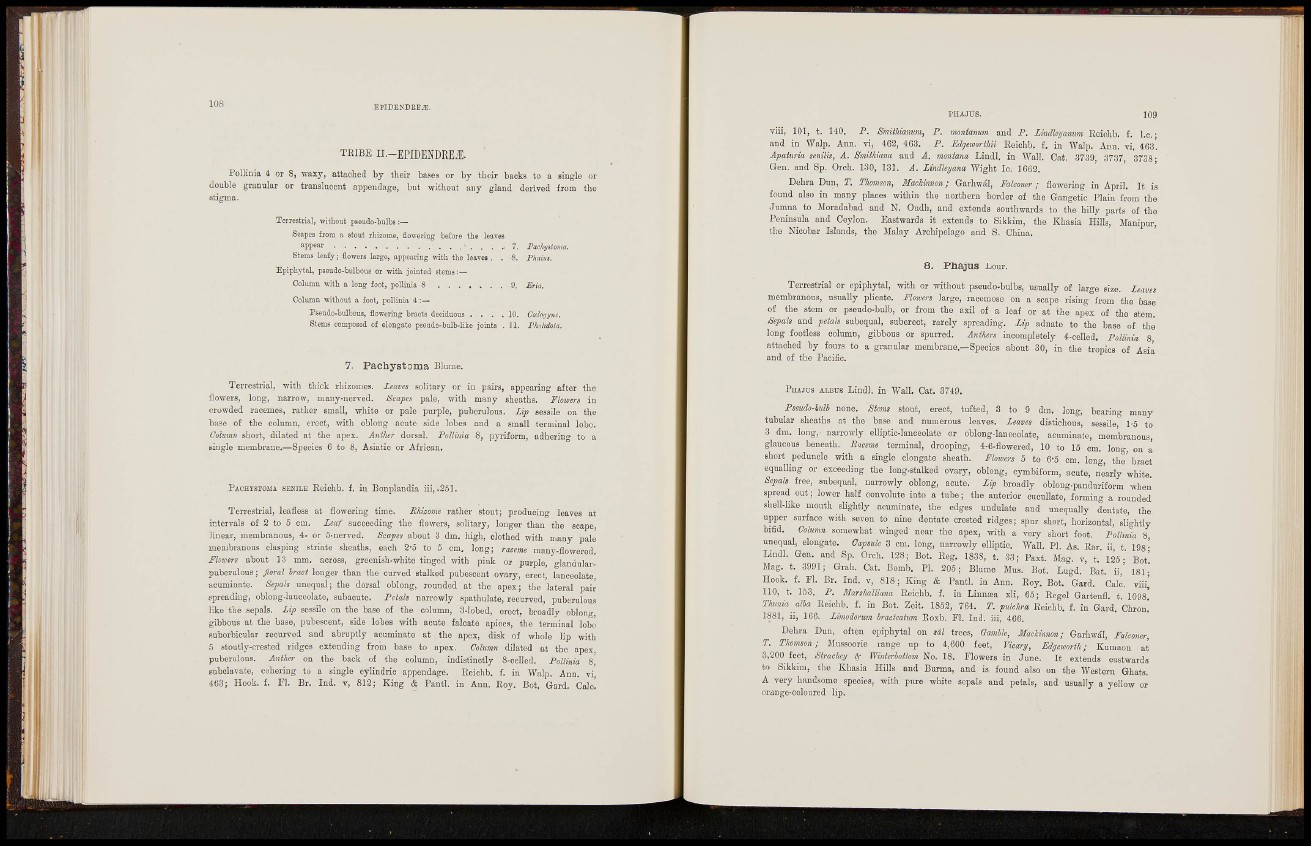
EPIDEINDREIE,
T R I B E n.-EPiDENDREi].
Pollinia 4 or S, waxy, attached by their bases or by their backs to a single or
double granular or translucent appendage, but without any gland derived from the
Terrestrial, •without pseudo-bulbs :—
Scapes f r om a stout rhizome, floweriEg before the leaves
appear 7. Pachyetoma.
Stems l e a f y ; flowers large, appearing with the leaves . . 8, Fhaius.
E p i p h y t a l , pseudo-bulbous or with jointed stems:—
Column m t h a long foot, pollinia 8 9. Eria.
Column without a foot, pollinia 4 :—
Pseudo-bulbous, flowering bracts deciduous . . . . 10. Ccehgyne.
Stems composed of elongate pseudo-bulb-like joints . ]1. Pholidoia.
7. Pachystoma Blume,
Terrestrial, -with thick rhizomes. Leaves solitary or in pairs, appearing after the
flowers, long, narrow, many-nerved. ¡Scapes pale, with many sheaths. Flowers in
crowded racemes, rather small, white or pale purple, puberulous. Lip sessile on the
biise of the column, erect, with oblong acute side lobes and a small terminal lobe.
Column short, dilated at the apes. Aniher dorsal. Pollinia 8, pyriform, adhering to a
single membrane.—Species 6 to 8, Asiatic or African.
PACHYSTOMA SENILE R e i c h b . f. i n B o n p l a n d i a i i i , . 2 5 1.
Terrestrial, leafless at flowering time. Rhizome rather stout; producing leaves at
intervals of 3 to 5 cm. Leaf succeeding the flowers, solitary, longer than the ecape,
linear, membranous, 4- or 5-nerved. Scapes about 3 dm. high, clothed with many pale
membranous clasping striate sheaths, each 2-5 to 5 cm. long; raceme many-flowered.
Flowers about 13 mm. across, greenish-white tinged with pink or purple, glandularpuberulous;
floral Iraci longer than the curved stalked pubescent ovary, erect, lanceolate
acuminate. Sepals unequal; the dorsal oblong, rounded at the apex; the lateral pair
spreading, oblong-lanceolate, subacute. Fciah narrowly spathulate, recurved, puborulous
like the sepals. Lip sessile on the base of the column, 3-lobed, erect, broadly oblong,
gibbous at the base, pubescent, side lobes with acute falcate apices, the terminal lobo
suborbicular recurved and abruptly acuminate at the apex, disk of whole lip with
5 stoutly-crested ridges extending from base to apes. Column dilated at the apex,
puberulous. Anther on the back of the column, indistinctly S-celled. Pollinia 8
Bobclavate, cohering to a single cylindiic appendage. Reiclib. f. in Walp. Ann. vi,
4t)3; Hook. f. Fl. Br. Ind. v, 812; King & Pantl. in Ann. Roy. Bot. Gard, Gale!
viii, 101, t. 140, P. Smithianum, P. monianum and P. Lindleyamm Reiclib. f. I.e.;
and in Walp. Ann. vi, 463, 463. P. Edgetuorthii Reichb. f, in Walp. Ann. vi, 463'.
Apaiuria senilis, A. SmitMana and A. montana Lindl. in Wall. Cat. 3739 3737 3738-
Gen. and Sp. Orch. 130, 131. A. Lindlcyana Wight Ic. 1G62.
Dehra Dun, T. Thomson, MacMnnon; Garhw^l, Falconer; flowering in April. It is
found also in many places within the northern border of the Gangetie Plain from the
Jumna to Moradabad and N. Oudh, and extends southwards to the hilly parts of the
Peninsula and Ceylon. Eastwards it extends to Siklsim, the Khasia Hills, Manipur,
the Nicobar Islands, the Malay Archipelago and S. China,
8. Phajus Lour.
Terrestrial or epiphytal, with or without pseudo-bulbs, usually of large size. Leaves
membranous, usually plicate. Floiven large, racemoso on a scape rising from the base
of the stem or pseudo-bulb, or from the axil of a leaf or at the apex of the stem.
Sepals and petals subequal, suberect, rarely spreading. Lip adnate to the base of the
long footless column, gibbous or spurred. Authors incompletely 4.ce21ed. Pomiia 8,
attached by fours to a granular membrane.—Species about 30, in the tropics of Asia
and of the Pacific.
PHAJOS ALBUS L i n d l . i n W a l l , C a t . 3 7 4 9.
Pseudo-hdb none. Sims stout, erect, tufted, 3 to 9 dm, long, bearing many
tubular sheaths at the base and numerous leaves. Leaves distichous, sessile 1-5 to
3 dm. long, narrowly elliptic-lanceolate or oblong.lanceolate, acuminato, membranous,
glaucous beneath. Racme terminal, drooping, 4-6-flowered, 10 to 15 cm. long, on a
short pcduncle with a single elongate sheath. Flowers 5 to 6-5 cm. long, the' bract
equalling or exceediog the long-stalked ovary, oblong, cymbiform, acute, nearly white
Sepals free, subequal, narrowly oblong, acute. Lip broadly oblong-panduriform when
spread out; lower half convolute into a tube; the anterior cuculiate, forming a rounded
shell-like mouth slightly acuminate, the edges undulate and unequally dentate, the
upper surface with seven to nine dentate crested ridges; spur short, horizontal sliUtly
bifid. Column somewhat winged near the apex, with a very short foot. PoUinia 8
unequal, elongate. Capsule 3 cm. long, narrowly elliptic. Wall. PI. As. Rar ii t 198-
Lindl. Gen. and Sp. Orch. 128; Bot. Reg. 1838, t. 33; Paxt. Mag. v, t. 125- Bot'
Mag. t. 3991; Grah. Cat. Bomb. PI. 205; Blume Mus. Bot. Lugd. Bat. ii,' 181-
Hook. f. H. Br. Ind. v, 818 ; King & Pantl. in Ann. Roy. Bot, Gard. Cale, viii^
110, t. 153. P. MarshaUiana Reichb. f. in Linnaja xli, 65; Regel Gartenfl. t. 1098'
Tkmia alia Reichb. f. in Bot. Zeit. 1853, 764. T. ptdchra Reichb. f. in G a i i Chron!
1881, ii, 166, Limodorum hracteatum Eoxb. Fl. Ind. iii, 466.
Dehra Dun, often epiphytal on sdl trees, Gamhle, MacMnnon; Garhwàl, Falconer,
T. Thomson; Mussoorie rango up to 4,600 feet, Vicary, Edgeworth ; Kumaon at
3,200 feet, Strachey éf WinterUttom No. 18, Flowers in June. It extends eastwards
to Sikkim, the Khasia Hills and Burma, and is found also on the Western Ghats.
A very handsome species, with pure white sepals and petals, and usually a yellow or
orange-coloured lip.